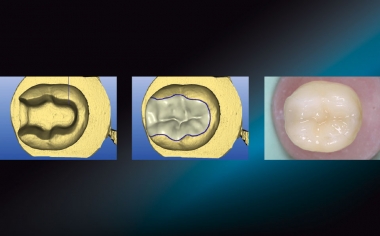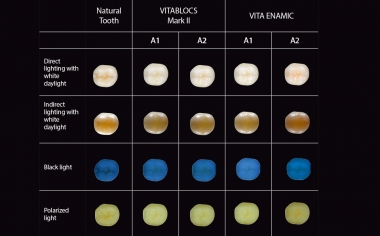VITA Zahnfabrik
H. Rauter GmbH & Co. KG
Spitalgasse 3
79713 Bad Säckingen

The Optical Integration Capacities of CAD/CAM Materials
Achieving excellent optical integration of CAD/CAM fabricated, monolithic inlays into the natural tooth substance requires materials that achieve natural light dynamics. That is why the material should have near-natural translucency, fluorescence and opalescence, in addition to shade accuracy. If a material meets all of the key parameters, completely harmonious integration is possible. During one study, subjects were asked to visually assess the optical integration of inlays from different CAD/CAM materials under four standardized light sources. PD Dr. Jan-Frederik Güth reports on the key findings of this study in the following interview.
DV: What criteria does a restoration material need to meet in order to achieve completely harmonious optical integration into the remaining tooth structure?
PD Dr. Jan-Frederik Güth: In addition to the shape, surface and matching tooth shade, the natural translucence of the material is also absolutely essential. Harmonious, optical integration is made possible primarily through near-natural light transmission. But other optical parameters, such as opalescence and fluorescence, also affect the natural appearance of a restoration.
DV: In a study, you investigated the quality of the optical integration of various restoration materials. How did you proceed in that case?
PD Dr. Jan-Frederik Güth: We produced geometrically identical partial restorations from different materials and standardized photographs under a variety of lighting conditions. We then presented the images to dentists and dental technicians, who were asked to evaluate the optical integration of the materials as compared to the natural tooth.
DV: What concrete findings can be concluded on the optical integration of VITABLOCS and VITA ENAMIC as a result of the test series?
PD Dr. Jan-Frederik Güth: Under daylight conditions, the monolithic inlays showed good optical integration and were hardly distinguishable from the natural tooth structure, even by experts. Under indirect lighting, the materials also showed no difference, but could be distinguished from the surrounding tooth structure.
DV: Where did the greatest difference lie in the materials examined in terms of photo-optical properties and what can be attributed to these differences?
PD Dr. Jan-Frederik Güth: There were significant differences in the fluorescence of the investigated materials. In comparison to the other materials and independent of the tooth shade, VITABLOCS Mark II feldspar ceramic and VITA ENAMIC hybrid ceramic showed very good optical integration here. However, the study was only based on one reference tooth, and natural teeth have different degrees of fluorescence.
DV: What recommendations for daily practice can be concluded from your study results for achieving attractive visual results?
PD Dr. Jan-Frederik Güth: As dentists, we have to focus very closely on the optical properties of CAD/CAM materials, especially when it comes to monolithic restorations. That goes well beyond determining the precise tooth shade and choosing the matching blank. I am sure that it is already possible for us to achieve esthetically pleasing, monolithic results today by choosing the right posterior material, and by taking parameters such as translucency and fluorescence into account.
DV: What should practitioners pay attention to in treating patients with prosthetic restorations in order to ensure good optical integration into the residual tooth structure that can be reproduced?
PD Dr. Jan-Frederik Güth: Translucence and shade effects are influenced by the restoration's wall thickness. And the composite cement also determines optimal light transmission through the restoration into the residual tooth structure and vice versa. I tend to go for brighter, translucent CAD/CAM blanks, and then modify the shade effects with more chromatic, fluorescent composite cements.
Report 11/18
PD Dr. Jan-Frederik Güth
Munich, Germany

Fig. 1: In the cavity of a test tooth, inlays made of different CAD/CAM materials were temporarily fixed with glycerine gel.

Fig. 2: Photographs of photo-optical integration of VITABLOCS and VITA ENAMIC under various light sources.
Study design: This study was a joint project between PD Dr. Pascal Magne (Herman Ostrow School of Dentistry, USC, Los Angeles) and PD Dr. Jan-Frederik Güth (Poliklinik für Zahnärztliche Prothetik, LMU, Munich). The aim was to examine the photo-optical behavior of geometrically identical, monolithic partial restorations from different CAD/CAM materials on a natural test tooth in order to provide practitioners with tips for achieving successful optical integrations. Six dentists and six dental technicians rated standardized restorations on 18 different restorations on a scale from 1 (low optical integration) to 4 (restoration not visible) under different light sources.
Source: PD Dr. Jan-Frederik Güth
Report: Study published in the Int J Esthet Dent 2016; 11:394-409.
Source header picture: Jorge Carro Juraez